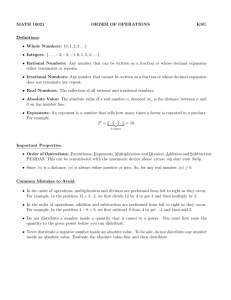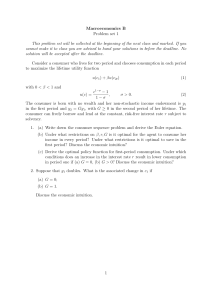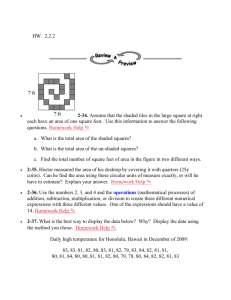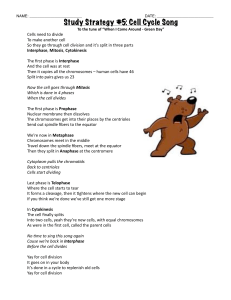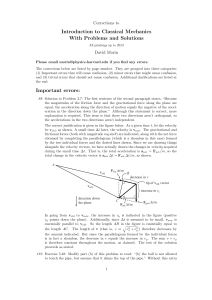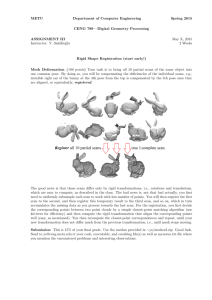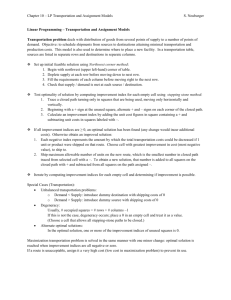2005 - 2006 Workouts Answers
advertisement
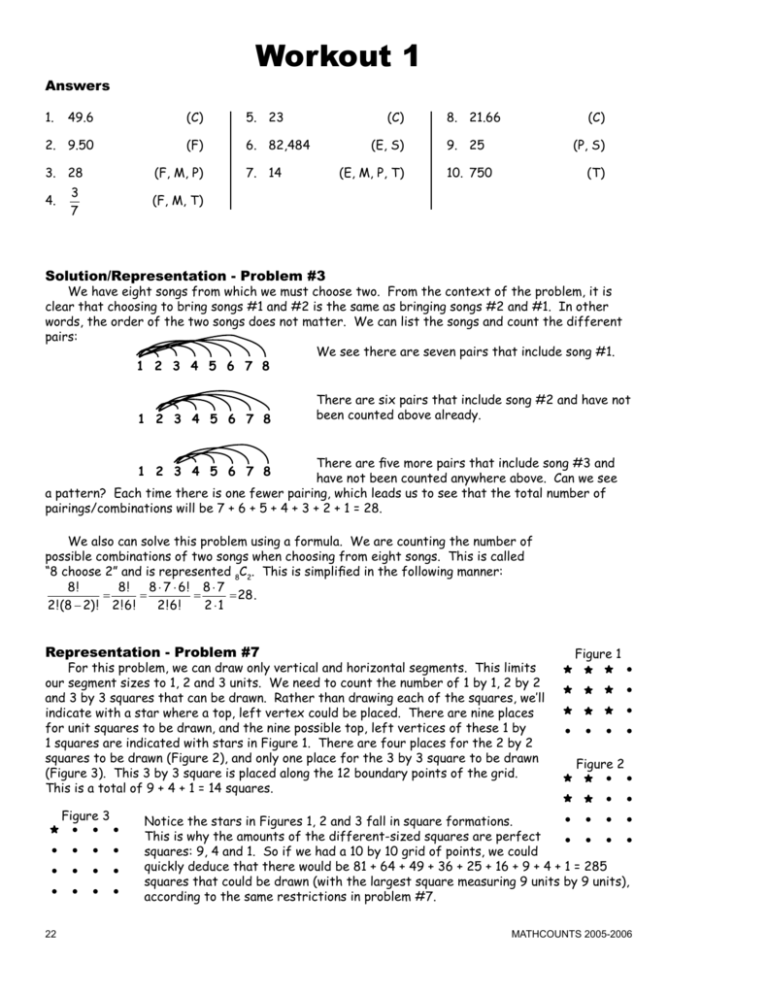
Workout 1 Answers 1. 49.6 (C) 5. 23 2. 9.50 (F) 6. 82,484 3. 28 4. 3 7 (F, M, P) (C) (E, S) 7. 14 (E, M, P, T) 8. 21.66 (C) 9. 25 (P, S) 10. 750 (T) (F, M, T) Solution/Representation - Problem #3 We have eight songs from which we must choose two. From the context of the problem, it is clear that choosing to bring songs #1 and #2 is the same as bringing songs #2 and #1. In other words, the order of the two songs does not matter. We can list the songs and count the different pairs: We see there are seven pairs that include song #1. 1 2 3 4 5 6 7 8 1 2 3 4 5 6 7 8 There are six pairs that include song #2 and have not been counted above already. There are five more pairs that include song #3 and have not been counted anywhere above. Can we see a pattern? Each time there is one fewer pairing, which leads us to see that the total number of pairings/combinations will be 7 + 6 + 5 + 4 + 3 + 2 + 1 = 28. 1 2 3 4 5 6 7 8 We also can solve this problem using a formula. We are counting the number of possible combinations of two songs when choosing from eight songs. This is called “8 choose 2” and is represented 8C2. This is simplified in the following manner: 8! 8! 8 ⋅ 7 ⋅ 6! 8 ⋅ 7 = = = = 28. 2!(8 − 2)! 2!6! 2!6! 2 ⋅1 Representation - Problem #7 For this problem, we can draw only vertical and horizontal segments. This limits our segment sizes to 1, 2 and 3 units. We need to count the number of 1 by 1, 2 by 2 and 3 by 3 squares that can be drawn. Rather than drawing each of the squares, we‛ll indicate with a star where a top, left vertex could be placed. There are nine places for unit squares to be drawn, and the nine possible top, left vertices of these 1 by 1 squares are indicated with stars in Figure 1. There are four places for the 2 by 2 squares to be drawn (Figure 2), and only one place for the 3 by 3 square to be drawn (Figure 3). This 3 by 3 square is placed along the 12 boundary points of the grid. This is a total of 9 + 4 + 1 = 14 squares. Figure 3 22 Figure 1 Figure 2 Notice the stars in Figures 1, 2 and 3 fall in square formations. This is why the amounts of the different-sized squares are perfect squares: 9, 4 and 1. So if we had a 10 by 10 grid of points, we could quickly deduce that there would be 81 + 64 + 49 + 36 + 25 + 16 + 9 + 4 + 1 = 285 squares that could be drawn (with the largest square measuring 9 units by 9 units), according to the same restrictions in problem #7. MATHCOUNTS 2005-2006 Workout 2 Answers 1. 6.7 2. 17 (C) 5. 27.60 (F) 8. 8 (T) (F, M) 6. 44.12 (F) 9. 12 (F) (G, M, S, T) 10. 35 (P, T) 3. 241.60 (F) 4. 42 (C) 7. 1 3 Solution - Problem #10 We are receiving a lot of items by the end of the fifth day! Let‛s see if we can get an accurate count. Making a table might be helpful, as shown below: Apples Bananas ??? Kiwis Lemons Daily Total Day 1 1 1 Day 2 1 2 Day 3 1 2 3 Day 4 1 2 3 4 Day 5 1 2 3 4 5 15 Item Total 1(5) 5 2(4) 8 3(3) 9 4(2) 8 5(1) 5 35 3 6 10 The subtotal of these items can be calculated across the rows or down the columns. We see from both ways of subtotaling that the grand total is 35 items over the course of the five days. Representation - Problem #7 We are told 20% of the students walks to school. This is represented in Figure 1 since we know 20% is equal to 51 . The portion of the figure representing the walkers is shaded. We are asked to double the number of walkers, but not change the number of Figure 1 Figure 2 non-walkers. This means we still have the same amount of unshaded space that we had before (non-walkers), but we need to hook on another shaded region (walkers) since the number of walkers doubles (Figure 2). Notice that instead of having the five congruent regions in Figure 1, we now have six congruent regions in Figure 2. Two of them are shaded to represent the walkers, so 26 or 31 of the students walkers walkers would be walkers. walkers Let‛s see if we can solve this problem with algebra. Let x be the original number of kids in the school. This means 0.2x is the number of walkers, and 0.8x is the number of non-walkers. We are told the 0.8x does not change, but the 0.2x number doubles, so it would become 0.4x. This means our new total number of students is = 0.4 = 124 = 31 . 0.8x + 0.4x = 1.2x. The fraction of students who are walkers is 0.4x 1.2x 1.2 28 MATHCOUNTS 2005-2006 Workout 3 Answers 1. 530 (F) 5. 112 (M, P, S) 8. 50 (E) 2. 25.69 (M) 6. −5 (E, G, M) 9. 1872 (F) 3. Maria, Jorge, Lo (C) 7. 20 (F, M, P) 10. 29 4. 207 (F, S) (F, M) Solution - Problem #5 We need to be sure we do not leave any positions for the 2 by 1 rectangle out of our count, while also ensuring that we do not count any positions more than once. (For our picture, arrows will be easier to see than rectangles.) Our arrows may only be placed in a horizontal position or a vertical position if they must cover two unit squares. Starting with the upper left square of our grid, we can place only two arrows that cover it while also remaining fully within the grid. One is vertical and one is horizontal. If we move to the second square of the top row, again, we have only two arrows that cover it, remain fully within the grid and do not go back to cover the first square. Remember, we do not want to recount an arrow that we have already counted. If we continue this process, we will see that each of the first seven squares in the first row yields two positions for a 2 by 1 arrow. However, the last square of the row will give us only one new arrow position. This is a total of 15 positions for arrows that cover a square in the first row. These are shown in the figure to the right. If we move to the second row, we will see that again we get 15 new positions for the 2 by 1 arrow. Remember that none of these positions may cover a square in the first row because those positions have already been counted. Each of our first seven rows will yield 15 new positions with this counting technique. However, the eighth row is different. There is only one position for the arrow that will cover the first square of the bottom row and no squares from the row above. The same is true for the second square in this row. There is only one position for a 2 by 1 arrow that does not cover any squares above it or to the left of it. Each of the first seven squares of this final row yields one new position. However, there are no new positions for the final square of the grid. This is a grand total of 7(15) + 7 = 105 + 7 = 112 positions for a 2 by 1 arrow (rectangle) in the 8 by 8 square board. Solution - Problem #10 To walk from one corner of the 90‛ by 90‛ square to the opposite corner, along the sides of the square, we would walk a total of 180‛. If we walk across the square, this distance will be shorter. The diagonal path across the square plaza splits our square into two isosceles right triangles with the diagonal path as the hypotenuse of both triangles. We can use the Pythagorean Theorem to determine the distance of this path. Let d be the length of our diagonal path. We have d2 = 902 + 902, which is d2 = 16,200 or d ≈ 127.28 feet. This is a difference of 180 − 127.28 = 52.72 feet, which is 52.72 ÷ 180 = 29% off the initial length. (Since we were working with an isosceles right triangle, we also could see that the diagonal path was equal to 90 2 ≈ 127.28 feet since the hypotenuse of a 45-45-90 triangle is the product of the length of the leg and 2 .) Because we have a formula for the diagonal path, we could check if our answer would remain the same for a square plaza of any size. Letting s be the side length of a square plaza, the long way from corner to opposite corner is 2s feet, and the diagonal route is s 2 feet. This is shorter by 2s − s 2 feet, which is a decrease of (2s − s 2 ) ÷ 2s = (2 − 2 )s ÷ 2s = (2 − 2 ) ÷ 2 = 29% for any value of s. 34 MATHCOUNTS 2005-2006 Workout 4 Answers 1. 2 5 84 (F, P) 5. 21.5 (F, M) 8. 2. 60 (G, T) 6. 0.150 (G, M) 9. 69 (C) 7. 16 (M, T) 10. 15 (F, M) 3. 24.6 4. 3149.28 (F) (G, M, P, T) (M, P, T) Solution - Problem #10 This problem is a little tricky because we have to figure out how far the train has traveled from the time the front engine entered the tunnel to the time the rear of the caboose left the tunnel. The tunnel is two miles long, but the train has actually traveled farther than this. The front of the train entered the tunnel, went two miles, exited the tunnel, and then went another half-mile before the end of the caboose was completely out of the tunnel. We need to find the number of minutes it took for this train to travel 2.5 miles. Using the equation Rate × Time = Distance, and knowing that the rate was 10 mph and the distance was 2.5 miles, we can set up an equation for the time (T) needed to complete the distance: 10 × T = 2.5 or 10T = 2.5. Dividing both sides of the equation by 10, we have T = 0.25. Remember that our rate was in mph, our distance ½ mile 2 miles was in miles, and so the time is in hours. The problem asked for the number of minutes, and 0.25 hours is a quarter of an hour, which is 15 minutes. Representation - Problem #4 We can approach this problem by figuring out the value of the motorcycle for each year until we reach the end of the fifth year. We know the motorcycle loses 20% of its value after the first year, so it keeps 80% of its value. This is (0.80)($6000) = $4800. After this first year, the motorcycle loses 10% of its value each year, so it will keep 90% of its value. After the second year, the motorcycle will be worth (0.90)($4800) = $4320. After the third year, its value will be (0.90)($4320) = $3888. After the fourth year, the value is (0.90)($3888) = $3499.20. And finally, after the fifth year, the value of the motorcycle is (0.90)($3499.20) = $3149.28. In this case we can see that we are performing the same multiplication process four times over the five-year period. (Remember that the motorcycle keeps a different portion of its value the first year.) Because of this repeated multiplication, we could save a couple of steps by using exponents. The long procedure in the solution above is equivalent to performing the following calculation: ($6000)(0.80)(0.90)4. With the help of a calculator, we see this is again $3149.28. Again remembering that we start with a value of $6000, go to $4800 after the first year, and then keep decreasing by 10%, we could come up with an equation that we could use for any year after the first year. Using the same logic that resulted in the expression ($6000)(0.80)(0.90)4 for the value after the fifth year, we can see that if we use the equation y = 4800(0.90)x−1, we can plug in any number of years (x) and determine the value of the car (y). This is helpful for answering questions like, “At the end of which year would the value of the car first be below $2500?” We could enter the equation Y1 = 4800(0.90)x−1 into a graphing calculator, see the ordered pairs on the TABLE screen, and see that y is first less than $2500 when x is 8. After eight years, the value of the car is about $2296, which is the first time it is less than $2500. 40 MATHCOUNTS 2005-2006 Workout 5 Answers 1. 9 (C) 5. 36 2. 4.475 (C) 6. 14.5 (F, G, M) 9. 18 (F, G, M, P, S) 7. 61 (E, G, T) 10. 46 (M, F) 3. 5 (F, M) 4. 130 (C) 8. 4.3 (F, M) (F, M, P, S, T) Solution - Problem #8 The first graph (left) is a typical pie graph. In both graphs, the area of the graph taken up by the Pop section must be 29% of the total graphing area. However, in the first graph, this Pop region is a sector of the circle. When Logan switches to the second SODA 67% graph, she still needs the Pop section to take up 29% of the SODA 67% area of the circle, but wants the Pop region to be a circular POP 29% region within the entire circle graph rather than a sector of COKE POP COKE OTHER 2% 29% the circle graph. The radius of this new graph is still 8 cm, 2% 2% OTHER meaning that the area within that boundary is 64π sq cm. 2% The Pop section of the new graph is still supposed to take up 29% of this area. We can calculate the area of this Pop region to be 0.29 × 64π ≈ 58.31 sq cm. We can now figure out the radius of this circular Pop region using πr2 = 58.31. Dividing both sides by π and then taking the square root, we see that the radius of the Pop circular region in the second graph is 4.3 cm, to the nearest tenth. Representation - Problem #3 Let‛s first graph the three vertices of this triangle and see what the triangle looks like. Unfortunately, it doesn‛t appear to be a triangle with an obvious base and/or height measurement. None of the sides are vertical or horizontal. However, notice that it is relatively easy to draw a rectangle such that the triangle is inscribed in the rectangle. The rectangle is 3 by 4, or 12 square units. It is comprised of the original triangle (shaded) and right triangles 1, 2 and 3. Since these last three triangles are right triangles, it is fairly easy to calculate their areas. Triangle 1 is 21 (1)(4) = 2 sq units; triangle 2 is 21 (2)(2) = 2 sq units; and triangle 3 is 21 (3)(2) = 3 sq units. These three triangles account for 2 + 2 + 3 = 7 sq units of the total 12 sq units, meaning that the area of the shaded triangle is left to be 12 − 7 = 5 sq units. y 1 −2 4 0 −8 2 2 0 0 1 −2 8 2 −4 −6 4 4 − (−6) = 10 46 B A C 1 2 B 3 A x 10 ÷ 2 = 5 C Because this is a convex polygon, we can use another method to determine the area of the triangle. Follow this algorithm, and then see how it works with other convex polygons you create. Step 1: Write the ordered pairs of the vertices in two columns, repeating the first listed ordered pair at the end. (We can start with any vertex, but we must then write the other vertices in order as they appear clockwise or counterclockwise around the figure.) Step 2: Write the products of the pairs of numbers found along the dotted diagonal lines in separate columns out to the sides. Step 3: Add these products together in each of the two columns. Step 4: Subtract these two sums and take the absolute value. Step 5: Divide this absolute value by 2. This is the area of the convex polygon. MATHCOUNTS 2005-2006 Workout 6 Answers 1. 15,444 (F, M) 5. ACEDB (T) 8. 68 (S, T) 9. (F, G) 2. 10 (T) 6. 21 (C) 3. 35 (E, G, M, T) 7. 6π (F, P) 4. 32 (F, M) 15 10. 40 + 20 5 (F, M) Solution - Problem #7 We can see the shaded area, and we are asked to find the sum of the arc lengths that bound the shaded area. We know that the arcs in question are semicircles. These arc lengths are then going to be half of the circumferences of their circles. The largest arc that bounds the top of the shaded region is a A C B semicircle with a diameter of 6 cm. The circumference of the circle is 6π cm, so the arc length is 3π cm. Now we need the arc lengths of the two semicircles 6 cm forming the lower boundary of the shaded region. We don‛t know, though, what the diameters of those circles are. We know only that the sum of the two diameters is 6 cm. Let‛s let the diameter AC be x cm, and the diameter CB will be (6 - x) cm. The circumferences of the two circles are xπ cm and (6 - x)π cm, and the arc lengths are then half of each of these. Notice the sum of the circumferences is xπ + (6 - x)π = xπ + 6π - xπ = 6π cm. The sum of the two arc lengths will then be half of this amount, which is 3π. So the sum of the arc lengths forming the boundary of the shaded region is 3π + 3π = 6π. Representation - Problem #3 For this problem we need to determine what combinations of 2½-inch and 1¾-inch panels result in a total of 83 inches. Since we want the least number of panels, we would prefer to make the 83 inches out of only the 2½-inch panels, or large panels (LP). However, when we divide 83 by 2½, we see that it does not have an integer result, meaning that we would need to cut a panel to make it fit exactly. Rather than using the fractions, let‛s use the decimal representations of 2.5 and 1.75. Since we now know we are going to have to use a 1.75-inch panel, or small panel (SP), notice that we would need two or four of them so that the sum of the 1.75-lengths ends in .50 or .00 and can be combined with a group of 2.5-inch panels. Making a chart, we can keep track of our attempts at making this work. We know using zero small panels will not work. Now we can check if # of SP Length of SP Length of LP # of LP using two of the small panels results in a 0 0 83 33.2 “left-over“ amount that is divisible by 2.5. 2 3.5 79.5 31.8 (We try 2 SPs, which is 3.5 inches, which then leaves 83 − 3.5 = 79.5 inches, and then 4 7 76 30.4 we see if this is a whole number of large 6 10.5 72.5 29 panels by calculating 79.5 ÷ 2.5. We get 31.8 LPs, which is not satisfactory.) If two SPs don‛t work, we can go to four SPs. The chart here shows we will use the least number of panels (35) if we use a combination of six small panels and 29 large panels. A graphing calculator also can be used for this problem. We know we need x small panels and y large panels, we want x + y to be as small as possible, and 1.75x + 2.5y = 83. If we work with this 83 equation by subtracting 1.75x from both sides and then dividing by 2.5, we have y = −1.75x . If + 2.5 2.5 we enter this into the “Y=” screen of our calculator, and then go to the TABLE function, we can see there are five ordered pairs where x and y are integers. We need the ordered pair with the lowest sum, which is when y is as large as possible. This happens at (6, 29), so there are 35 panels. 52 MATHCOUNTS 2005-2006 Workout 7 Answers 1. 40 2. 2 3. 12 4. 9886 (F, M) (C) (F, M) 5. 859 6. (5, 5) 7. 9 (F, M) 8. 59 (E, G, S) (G, M, T) 9. 24 (F, M) 10. 495 (P, T) (M) (P, S, T) Solution - Problem #5 We need to find the area of the entire shaded region, which can be thought of as the sum of five separate regions. There are four circles and then the curved diamond region in the middle. Finding the area of circles is not too bad, but getting that middle portion could be tricky! Is there another way to break up the picture? What if we break the figure up like we have in this second figure where we have a square and four three-quarter circles? Since the radius of each circle is 8 feet, each side of the square is 16 feet. The area of the square is 162 = 256 sq ft. Now we have the four three-quarter circles. The area of a complete circle is π(8)2 = 64π. Three-quarters of this area is 48π. There are four of these regions, which makes their total area 4 × 48π = 192π. The area of the complete patio is 256 + 192π ≈ 859 sq ft. 8 8 Representation - Problem #10 To fill in the entries of Pascal‛s Triangle, we add the two closest numbers in the row directly above the missing entry. (Notice the first 10 in Row 5 is beneath a 4 and a 6 in Row 4.) Each row will have one more entry than the row above it, 1 Row 0 and a 1 is always the first and last entry of each 1 1 Row 1 row. Filling in all of the missing entries until we th get to the 12 row could take a while, but notice 1 2 1 Row 2 that we would not have to fill in every number of 1 3 3 1 the 11th row to determine the fifth entry of the 1 4 6 4 1 12th row. We would really need to know only the th fourth and fifth entry of the 11 row. Likewise, 1 5 10 10 5 1 we wouldn‛t have to figure out every entry of the 10th row. We would need to know only the third through fifth entries. Recognizing this will cut down on the work we need to do. Though brute force will get us to an answer here, is there an easier way? Do any of the numbers in these rows form patterns that look familiar? The entries in Pascal‛s Triangle are the numbers we get when we look for combinations. For instance, if we have five items, and we want to know how many ways we can pick one item, the answer is 5. If we want to know how many ways we can choose two items from the five, the answer is 5C2 = 10. If we want to know how many ways we can choose three items, the answer is 5C3 = 10. (It makes sense that 5C2 and 5C3 are the same since every time we choose 2 items to include, we also have actually chosen a group of three items not to include.) Continuing with this logic, if we want to choose only four items, we have 5C4 = 5 (and notice that this is the same as 5C1). And how many groups of five can be made from five things? Yes, just 1. Notice that the different ways to select from five items are the entries in Row 5 of Pascal‛s Triangle. The first and sixth entries are 5C0 and 5C5, respectively, which are both equal to 1. So if the third entry in Row 5 is 5C2 , then it would follow that the fifth entry in Row 12 is 12C4 = 495. 58 MATHCOUNTS 2005-2006 Workout 8 Answers 1. 4.8 (C) 2. 9000 5. 25 (F, C, S) 3. 2 (C) 4. 40 (G, T) 8. 42.4 (F, M) 6. 23.6 (C, P, T) 9. 10 (F, P, T) 7. 56 (F, M, P) 10. 39 (F, M, S) (P, T) Solution - Problem #2 We are told that the margin of error for a particular survey is related to the number of people surveyed and a constant. The constant will not change, but when the number of people being surveyed changes, the margin of error changes. Let K be our constant for the survey. A survey of 1000 people had a margin of error of 3%. According to the formula we were given, we can set up K the equation .03 = 1000 . Since K is a constant, it will be very helpful to know the value of K. Solving this equation by multiplying both sides of the equation by the square root of 1000, we find K ≈ 0.94868. We have been asked to find the number of people needed for a 1% margin of error. Let P be the number of people needed, and we have the equation .01 = KP . We now need to solve for P. Multiplying both sides of the equation by the square root of P and then dividing both sides by K .01 gets us to the equation P = .01 . We still have the value of K in our calculator (hopefully!) from the first equation, so we can divide that by the 0.01, and we have 94.8683. This is now the value of the square root of P. For the value of P, we square 94.8683 and see P = 9000. (Notice that if no rounding is ever done, the answer is exactly 9000.) Rather than first finding K, we also could see that 3% is three times 1%. Therefore, the value of the constant divided by the square root of the number of people in the first scenario is three times the value of the constant divided by the square root of the number of people in the second scenario. With this equation, we can see below how the answer can be found without a calculator. K 1000 = 3( KP ) ⇒ K 1000 = 3K P ⇒ 1 1000 = 3 P ⇒ P = 3 1000 ⇒ P = 9 ⋅1000 ⇒ P = 9000 Representation - Problem #5 Forty percent is equivalent to two out of five, and 40% of 50 is 20. This means there are 20 girls and 30 boys at the start, making up the 50 original students. Figure 1 represents this situation. Two of the five columns have Gs for girls, and three of the five Figure 1 columns have Bs for boys. Each square represents five students. We now need to add enough G squares so that the percent of girls is 60%, which G G B B B is three out of five. This means we need to add squares, but still keep our five total columns. Three of the columns will now need to be filled with G G B B B Gs, and two of the columns will need to be filled with Bs. Let‛s move two B squares into the right-most two columns (Figure 2). We then have our two B columns out of five total columns. How many G squares are needed to finish out the three left-most columns? We have five empty squares for Gs, which is really Figure 2 5 × 5 = 25 girls. (For this representation, it is now clearer why Figure 1 used six Bs and four Gs rather than three Bs and two Gs. Redistributing G G B B B one B square into two columns would not have worked.) G 64 G B B B B B MATHCOUNTS 2005-2006 Workout 9 Answers 2 19 (F, T) 2. 76 (E) 6. 3.5 3. 60 (C) 7. 480 1. 4. 20,100 5. 16 (E, G, M, S) 8. 12 (M, P) (F) 9. 31 (E, G, S) (P, S, T) 10. 480 (P) (F, P, S) Solution - Problem #7 We have six people lining up at a fountain. There are 6! = 720 ways they could do this. However, we have illegally included the ways where the girls are beside each other. Let‛s assume a girl is first in line. This leaves four possible positions for the other G __ __ __ __ __ __ girl. If a girl is in the second spot, the other girl only has three G __ __ __ __ __ __ possible positions. If a girl is in the third spot, there are only two possible spots for the second girl. (Notice that girls in positions G __ __ __ __ __ __ 1 & 3 have already been counted, so we are looking only to the right G __ __ __ __ __ __ of the first G we place in the sequence.) Finally, if a girl is in the fourth position, the only new combination is for the other girl to be in the last position. This is a total of 10 different legal formations of Gs and Bs. We are not done, though, because we are not simply placing Gs and Bs. We are placing actual people. Consider GBGBBB. There are two options for the first G (either Abby or Bonnie), four options for the first B (either Chuck, Dennis, Ed or Fred), one option for the second G (whichever girl was not used in the first G position), three options for the second B, two options for the third B and one option for the fourth B (whoever is left). This is a total of 2 × 4 × 1 × 3 × 2 × 1 = 48 distinct lines of students at the water fountain following the GBGBBB formation. There are 48 distinct lines for each of the 10 formations, which is a total of 48 × 10 = 480 possible ways for the six people to line up according to the restrictions. Representation - Problem #3 One solution for this problem simply involves writing an equation for the situation and solving the equation. We know (the number of correct answers given for the first 100 questions) + (the number of correct answers given for the set of additional 25 questions) = (the total number of correct answers for the 125 questions). Using the information from the problem and letting x be the percent of the additional 25 questions answered correctly, the sentence equation above can be rewritten: 35 + x%(25) = 40%(125). This equation can be solved for x (without even using a calculator!) with the following steps. 35 + x%(25) = 40%(125) 35 + (x%)(25) = (40%)(5)(25) 35 + (x%)(25) = (200%)(25) 35 + (x%)(25) = 50 (x%)(25) = 15 x% = 15/25 x% = 60/100 x = 60 Rather than translating the situation to an equation, we also could reason through what happened. We know Marian was asked a total of 125 questions. Of those, 40% were answered correctly, which is 0.40(125) = 50 correct answers. Before the last 25 questions, she had already answered 35 of the first 100 questions correctly. This means she correctly answered 50 − 35 = 15 of the last 25 questions correctly, which is 15 ÷ 25 = 60%. 70 MATHCOUNTS 2005-2006
